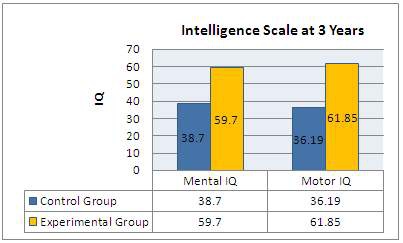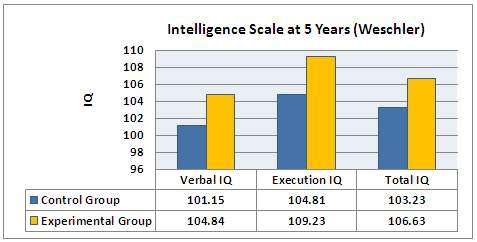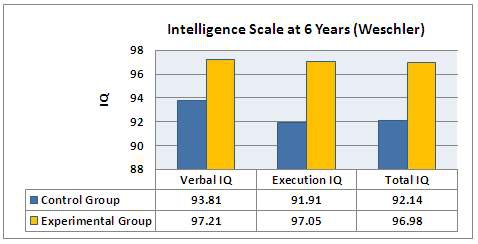Chapter 3 - Previous Studies on the Development of Intelligence Using Prenatal Enrichment
The nature-nurture debate has been going on for years questioning whether a person’s personality and intellectual development is largely a result of genetics, or environment. There have been numerous studies conducted to investigate the role of the environment on a child’s intellectual development and all of them have concluded that a child’s IQ can be negatively or positively affected by her environment. In fact, they suggest that a stimulating environment will impact positively on her intellectual development, whereas a deprived environment will impact negatively.
Parents tend to embrace the pregnancy and birth of their child with joy when the pregnancy is planned. It gives them the freedom to bestow love and attention on their unborn child – a practice which dates back centuries and across cultures. In fact Chinese women are still reminded by posters that when an empress was pregnant she would take care of her unborn child by avoiding offensive music, words or unpleasant sights in an attempt to make them aware of how environment can influence even an unborn child.
The idea of nurturing your unborn child during pregnancy dates back centuries, but actually focusing on education during pregnancy only started in 1980 with Leni Schwartz in a program entitled “The world of the Unborn: Nurturing your Child Before Birth” (2nd ed. 1991). This was followed by Eve Marnie’s “Pre-birth Bonding” in 1988 and then Thomas Verny and Pamela Weintraub introduced “nurturing the Unborn Page 41 Child” in 1991. While these programs concentrated on a bonding and educational program during pregnancy, none of the research was aimed at actually measuring their effect on the babies after birth.
In fact, studies on the effect of prenatal stimulation on babies post birth only began in 1986 with Rene Van de Carr where significant differences were reported in earl speech, growth, bonding and success of breastfeeding in babies who experienced prenatal stimulation as compared to babies who had not. In 1988 a similar study conducted by obstetricians found that higher Apgar scores were associated with babies who had experienced prenatal stimulation. Furthermore, the mothers also reported an “easier than expected” birth in cases where prenatal stimulation was involved. The latest version of this program – “While You’re Expecting: Create Your Own Prenatal Classroom” has been available since 1997.
Your own attempts at prenatal stimulation may well have been met with ridicule and disdain where may people still believe that prenatal stimulation, talking to your unborn child and looking after maternal health is a waste of time and will have no significant effect on your baby. Rest assured these people are wrong. We have created this book with sound advice and tips on how to stimulate your baby and raise a happy and confident child based only on sound research. There have been countless studies on the topic that support the information in this book, too many to mention in this chapter alone. But to set your mind at ease, we have focused on a few significant experimental studies.
Here is a brief explanation of how experimental studies work: in an experimental study you will have two groups of people, known as the subjects, who are of similar demographics. One group will be the experimental group while the other will be the control group. Now the experimental group will be the group who undergoes a series of activities or experiments over a set period of time while the control group is not subjected to these activities or experiments. Remember that both groups are of similar age, education level, gender, socio-economic status and will have similar living arrangements – the only significant difference will be that one group undergoes the experiment while the other dies not. The differences (if any) between the two groups after the experiment is conducted is then measured to see what type of effect the experiment had on the experimental group. So in the examples given here pregnant women were studied.
One group, the experimental group, would have done some form of prenatal stimulation, while the other group, the control group, did not. The conclusions of the studies cited in this chapter will show the comparison of the mental and emotional differences of the babies in each group. Should you require more detailed information about each of the studies, please refer to the reference list at the end of the chapter.
3.1 The “Glenwood State School”
A study conducted by Skeels looked at twenty-five children from an orphanage with very low IQ’s. Due to the fact that they were living in an orphanage, their environment was deprived of individual care and attention, particularly due to being overcrowded and understaffed. Skeel transferred thirteen of the babies with an average IQ of 64 and average age of nineteen months to the Glenwood State School for mentally retarded women. One woman would then be personally responsible for a baby. The average IQ of the babies that stayed behind in the orphanage was 87. The babies transferred were placed into open and active wards where the women who were taking care of them provided them with attention and care, offering toys to play with and taking them on outings. These women were all taught how to stimulate the babies.
After eighteen months the babies who were transferred to the Glenwood State School were compared with the babies who had remained in the deprived environment of the orphanage. It was surprising to find that the babies from the state school had an increase of 29 points in IQ. In a follow up study conducted two and a half years later, eleven of those babies had been fortunate enough to be adopted and their average IQ had increased from 64 to 101.
The two babies who had not been adopted were back in an orphanage and had lost the initial increase. In the control group – the babies who had remained at the orphanage – had a decrease in average IQ from 84 to 66 in the follow up study.
Moreover, the difference in quality of life between the two groups was significant. A further follow up study of these children as young adults revealed that the experimental group had progressed into “productive and functioning adults” while the majority of the control group were found to have mental retardation and had been re-institutionalized.
3.2. The “Project Family”
A longitudinal study of 684 families was conducted in Venezuela where psychologist Beatriz Manrique explored the bio-psycho-social development of children through prenatal stimulation and nutrition. This project was called “Projecto Familia” or “Project Family”. The prenatal enrichment was taught to two groups of pregnant women over 13 weeks for 2 hours per week. The pregnant women were all first time moms between the ages of eighteen and twenty six.
There were two other groups of pregnant women of similar demographic who were not taught prenatal enrichment. The mothers in the experimental group were taught to talk with their babies from as early as the fifth month of pregnancy when their babies had begun to move and kick.
Family members were also encouraged to talk to the baby and encourage movement through saying words such as “pat, squeeze, stroke and tap” while touching the mother’s pregnant belly. Loud noises and music was also used as well as visual stimulation with light and dark, and thermal stimulation of hot and cold.
The mothers and family members made every effort verbally and through touch and movement to encourage the baby kick, push and roll. Measurements were then taken during and after the births of the babies and the babies were thereafter studied at two days, eighteen months, three years and then each year until the age of six.

The measurements consistently showed that the babies in the experimental group who had received appropriate prenatal enrichment, appropriate stimulation and good nutrition had better visual, auditory, language, memory and motor skills. During labor and immediately following the birth of their babies the mothers from the experimental group were able to direct their energy better and to relax more than the control group mothers.
The experimental group mothers also had higher self-esteem and positive feelings regarding pregnancy. Furthermore, the experimental group mothers had greater success with breastfeeding as when compared with the control group. Moreover, the mothers had more confidence in their ability to parent and there was better bonding and family cohesion with the babies from the experimental group than from the control group. The stimulated babies measured at two days old were better able to follow visual and auditory stimulation than their control group counterparts and demonstrated better muscle tone with more movement of their heads and bodies. By the age of twenty five days, the experimental group babies showed better visual and auditory ability and were better able to self-regulate during stressful situations.
In general, the babies who had been stimulated showed a better developed nervous system than those who had not been stimulated. When the babies were measured at eighteen months the experimental group babies outperformed the control group on tests measuring gross muscle control, language development, hand-eye coordination and problem solving abilities. Later measurements when the babies were older showed that the babies from the experimental group continued to outperform their control group counterparts (Manrique et al, 1998).
When measured at the age of three the children in the experimental group showed significantly higher scores in both mental and motor IQ tests (fig. 3.1) By ages four and five the children were measured with standard IQ tests and the children from the control group scored significantly lower in verbal IQ, execution IQ and global IQ than the experimental group (fig. 3.2) By the age of five (fig.3.3) the experimental group showed better general knowledge and had a better vocabulary than the control group children. In fact they were better at reading and writing and they were expected to do better at school than the control group children.

Fig 3.1: Intelligence Scale at 3 Years: Stanford-Binet/McCarthy 18

Fig 3.2: Intelligence scale at 4 Years (Weschler) WPSSI

Fig 3.3: Intelligence scale at 5 Years, (Weschler) WPSSI 20

Fig 3.4 Intelligence scale at 6 Years (WISC Scale)
SOURCE: Data taken from the book Manrique, B., Contasti, M., Alvarado, M. A., Zypman, Monica, Palma, N., Ierrobino, M. T., Ramirez, I., & Carini, D. (1998). A controlled experiment in prenatal enrichment with 684 families in Caracas, Venezuela.
3.3 The Firstart Method
A musical couple in Spain introduced the “firstart” program where violin sounds were broadcast to the fetus. Not only was music played to the fetus, but parents were also encouraged to record their voices talking or singing and broadcast these to the fetus as well through a mini tape player and speaker worn around the mother’s belly. S study to measure the effects of this program was then conducted by a group of developmental psychologists in Valencia (Spain).
The program was applied to 101 mothers in the experimental group with 71 mothers in the control group and both groups attended the hospitals birth preparation course. The mothers in the experimental group exposed their unborn babies to an average of 70 hours of music from 28 weeks gestational age right through to the end of the pregnancy. The music was in the form of violin sounds played through the mini tape player-speaker system.
The first measurements taken were at six months of age where mothers were asked to chart their baby’s development from birth to six months of age. As suspected, the experimental group babies were found to be advanced when compared to the control group. They showed superior gross and fine motor skills as well as increased linguistic ability and sensory coordination. They showed signs of exploring things with their mouths, visually tracked their mothers and showed anticipatory behaviors such as stopping crying when they could hear their mothers approaching.
They were also able to mimic their mothers and started babbling a little earlier than their control group counterparts. In the second measurement at twelve months these findings were continued although there was some narrowing in the gap between the experimental group and the control group. There were still a significant difference in the production and understanding of language, which was ascribed to the auditory stimulation that the experimental group babies received while in utero.
3.4 The Sentient Prenate: What Every Parent Should Know
In 1993 David Chamberlain, author of “Babies Remember Birth” discussed research at the 1st World Congress on Prenatal Education that supported four important claims: that babies in the womb are (1)sensitive and aware, (2) can learn and dream, (3) are social and communicative and (4) that intelligent babies need intelligent parents.
The research discussed by Chamberlain showed that a 24 week old fetus would react when stuck with a needle by twisting away from the needle and would also strike the barrel of the needle until it was removed from the womb. This was observed through an ultrasound. He also concluded that babies could suffer many traumas as a result of birthing procedures and, as they were sensitive and aware (as depicted by the fetus and the needle), delivery rooms should not be brightly lit, cold and rough. When looking at studies on fetal hearing and learning, Chamberlain highlighted several studies showing that babies’ first cries often had the same speech characteristics and intonations as that of the mother. Babies could also learn songs and recognize familiar tunes, as well as learn how to respond to specific stimuli based on the mother’s response to stressors. Lastly, he showed that EEG results of premature babies suggested that babies could dream from as early as 23 weeks gestational age.
Chamberlain also cited a particular study on a father who would return from work each day and greet his unborn baby. During the 25th week of gestation the fetus kicked his fathers cheek during the greeting and this continued every day until the pregnancy ended. This particular study suggested that babies are social and can communicate while in the womb. Chamberlain also went as far as to argue that intelligent babies needed intelligent parents. This was argued by highlighting studies on thousands of women who experienced depression during their pregnancies and showed that depressed mothers were more likely to have babies who cried incessantly and anxious mothers were more likely to have cranky, colicky babies. Probably the most important finding was that babies who were unwanted from the start had higher incidents of psychological problems, learning problems and behavior problems than babies who were planned and wanted from conception.

Essentially Dr. Chamberlain was influential in proving how babies are aware, sensitive and capable of learning even before birth.
3.5 Project Pre-learn
Brent Logan conducted a study in 1986 where he also explored the effect of prenatal stimulation on babies. In his study he looked at 11 mothers who played recorded sounds to their fetus through earphones on their bellies. The recorded sound included sounds that resembled the mother’s pulse as it would sound through the uterine wall and this was played for two hours per day. When the mothers gave birth, 10 of the 12 babies (one of the mothers had twins) did not cry at all, while the 11th baby cried with distress from being delivered by forceps.
Moreover, the vast majority of the babies began to babble and coo. In fact, two syllable babbles such as ‘ah-goo’ were made by 10 of the babies and one baby was even able to say ‘mama’! All of the babies were interested in people and objects and would follow the direction of sounds. In general, these babies were referred to as being “calm” and “well behaved” by the hospital staff.
Six months later the language and auditory skills of the babies were assessed using the Clinical Linguistic and Auditory Milestone Scale and it was found that all the babies showed an 8.5 month advance over babies in the control group. With regards to social maturity, the babies’ maturity was equal to between 12.3 and 14.3 months age – showing a big gap between their chronological ages and their social maturity age.
3.6 Prenatal Infant Stimulation Program
Another study was conducted by Chairat Panthuraampharn in 1990 evaluating a prenatal stimulation program developed in Thailand that was designed to enhance the mother-child attachment. The program was given to 12 women in the experimental group and it consisted of massage, teaching breathing exercises, relaxation and visualization exercises, sensory stimulation for the mother as well as auditory, tactile and visual stimulation for the fetus.
The study operated under the knowledge that a fetus can hear, see, taste and move throughout the second and third trimester. As such, the belief was that a mother who was stressed was also far more likely to have an irritable and anxious baby. The mothers in the experimental group were, thus, encouraged to reduce stress and to bond with their fetus with love and optimism to promote positive emotions.
The fathers were not ignored in this study and they were also encouraged to spend quality time together and promote a healthy relationship between mother and father. The fathers were also enlisted in giving soothing massages to the mother and to assist with the breathing and relaxation exercises. The relaxation exercises were to be practiced daily for 5 minutes and mothers were also encouraged to listen to relaxing Thai music while having a relaxing bath and visualizing a positive birth. Furthermore, mothers were asked to talk to and sing to their fetus while gently tapping their abdomen. Tactile stimulation was provided through the application of hot and cold water bottles to the mothers belly on a daily basis. This was coupled with a water spray massage from the 24th week of pregnancy. Visual stimulation started at the 30th week and included moving a white, green and red light across the mother’s tummy, which often caused the baby to turn to or move in the direction of the light.
The findings of the study concluded that the babies in the experimental group had a larger head circumference at two months than those in the control group. Furthermore, the experimental group babies scored better in personal and social development, language skills and fine and gross motor skills than their control group counterparts.
3.7 Milwaukee Study
The effect of intellectual stimulation on deprived babies was studied in 1960 by Rick Herber. After examining different districts in Milwaukee, Herber found the district with the lowest average income and the lowest level of education, while also having the highest population and unemployment rate. Most importantly, this district accounted for 33% of Milwaukee’s children who had been diagnosed with mental retardation. This district was used to sample babies from a “deprived environment”. Forty newborns were selected from this deprived district and the mothers of these babies all had IQs below 80. These newborns were randomly assigned to the experimental group and the control group.
The experimental group was entered into a program where the mothers received education and training in home making and child care. The babies’ home environments were also enriched for the first three months of their lives after which they attended a special center for five days a week. The center focused on language development and development of other skills while the control group did not receive any enrichment, education or intervention whatsoever.
The findings of the study show that all the children in the experimental group were significantly superior to the children in the control group by the age of six years. In fact all tests measuring the two groups confirmed this, especially in areas of problem solving and language development. By the age of six, the experimental group had an average IQ of 120.7, while the control group had an average of 87.2. By age ten, the IQ scores were 105 and 85 respectively showing a consistent superiority over the control group.
3.8 Other Examples of IQ Increase
Israel is another country where examples of increased IQ through prenatal stimulation programs can be found. Here children with European Jewish heritage have an IQ of 105 while those with Middle Eastern Jewish heritage only have an average IQ of 85. Interestingly, children from both groups who were raised on a Kibbutz had an average IQ of 115.
In New York another home-based enrichment program consisted of an instructor who made two visits per week for seven months showing parents how to teach their children from home. In this program the initial IQs were in the low 90s but had increased to 108 by the time the children went to school. These children then continued to demonstrate their intellectual ability in school achievement tests.

| Summary
● Several large studies have demonstrated that babies can see, feel, hear and are alert and sensitive while still in the womb. Providing stimulation to thedeveloping fetus drastically increases its cognitive and emotional development. Ensuring that the pregnant mother is well cared for, positive and optimistic regarding the pregnancy also contributes to a more positive birth experience and mother-child bonding ● Babies from prenatal stimulation programs and home based enrichment programs have consistently shown higher results on a variety of IQ and cognitive developments tests. In fact these babies grow into children who also have consistently higher IQs than babies who were not stimulated prenatally. ● A variety of studies have proven that prenatal care, nutrition and fetal stimulation is directly linked to intellectual and emotional superiority. |
